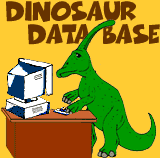

 Frequently
Asked Questions and Answers about Dinosaurs
Frequently
Asked Questions and Answers about Dinosaurs
Q: What is the largest known dinosaur?
A: The Tyrannosaurus Rex (40 ft. long, 18 ft. to head, and 6 tons) is the largest meat-eating dinosaur known, but the true giants were the sauropods. There is much discrepancy about which of these was actually the biggest. The heaviest of these was thought to be the Brachiosaurus weighing 55 tons. That's about as much as 11 African elephants! However, the recent discoveries of enormous vertebrae and sacrum bones from Argentinosaurus (a close relative of the Brachiosaurus) have caused some paleontologists to believe this could be the heaviest dinosaur.
The longest dinosaur is considered by many to be the Seismosaurus (size-ma-SAW-rus), a relative of the Diplodocus, with a length of up to 150 feet. Another contender for the longest and heaviest is the Supersaurus. We may never know exactly which dinosaur was the biggest, but we can be fairly sure it was a sauropod of some kind!
Q: Were dinosaurs warm-blooded or cold-blooded?
A: If dinosaurs were warm-blooded or cold-blooded, there is no definite answer. For many years, scientists thought all dinosaurs were cold-blooded. Then, in the 1970s, scientists begin to look at some evidence indicating that dinosaurs may be warm-blooded. This evidence included several things: the way dinosaurs stood straight-legged like mammals, their big rib cages that could have held mammal-like hearts and lungs, and bones that contained channels for quick blood circulation as found in warm-blooded animals' bones. More recent studies, however, indicate that dinosaurs were neither warm-blooded like mammals nor cold-blooded like reptiles, but in between. Meat-eaters like the Tyrannosaurus Rex may have been able to regulate their body temperature but not to the extent that mammals and birds do today. Big plant-eating dinosaurs did not seem to have much control over their body temperature, but were not as cold-blooded as modern reptiles.
Q: Did giant sauropods like the Apatosaurus need to be in deep water to move easily because they were too heavy to support themselves on land?
A: Regarding the Apatosaurus' and other sauropods' need to live in deep waters, there is little evidence to support this theory. For nearly a century, this theory was supported by early paleontologists based on the belief that the sauropods' legs could not support their weight, and their teeth could only chew soft, aquatic plants. However, modern paleontologists believe that their huge legs could indeed support their weight. Their strong teeth were designed to chew tough vegetation. This evidence indicates that sauropods were leaf-eating land animals much like giraffes and elephants today.
Q: How do dinosaurs get their names?
A: When a new dinosaur is discovered, it can be named in one of the following ways:
Dinosaurs can be named after a person. Herrerasaurus was named after Señor Herrera, one of the discoverer's friends. Some dinosaurs are named after the place where their bones were discovered. Albertosaurus was found in Alberta, Canada.
Other dinosaurs get their names from a certain physical characteristic. Iguanadon has teeth like an iguana. Dienonychus has a terrible claw. Many dinosaurs names seem long and difficult to pronounce. Often, the names contain Greek or Latin words. Many words come from these two languages, and they are recognized by the worldwide scientific community.
Q: What makes a dinosaur a dinosaur?
A: To be classified as a dinosaur, an animal must have:
Because animals such as the flying pterosaurs and the sprawling crocodilians may share some of these characteristics, but not all of them, they cannot be considered dinosaurs.
Sources:
Kinetosaurs Home Page
Copyright 1999 The Children's Museum of Indianapolis